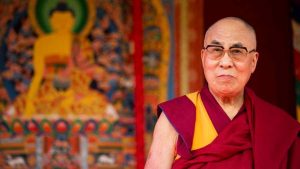Source: www.thequint.com /opinion/22/03/2018
The Tibetans in exile must be dismayed after India’s Foreign Secretary Vijay Gokhale wrote to Cabinet Secretary PK Sinha on 22 Feb that Indian government officials be advised to skip events organised by the Tibetan Administration in exile. It is not at all certain that the payback from China for alienating the Dalai Lama is going to be commensurate with India’s act.
India’s objectives in slighting the Central Tibetan Administration (CTA), as the Tibetan government in exile is known, and indirectly the Dalai Lama, remain unclear. No one knows what understanding, if any, has been reached with China prompting such action. However, its negative consequences are already at play.
The Dalai Lama effectively un-invited himself from the plenary session of the Indian Science Congress in Manipur. Reluctant to embarrass the Indian government, the Tibetan leader turned down the invitation to be present at the plenary session with Prime Minister Narendra Modi. To allow a face-saver, his office claimed that the invitation, which the organisers said had been extended two months ago, was never received by him.
The Dalai Lama is also bound to have been deeply embarrassed, as Gokhale’s directive was leaked in the midst of his 33rd ‘Mind & Life’ dialogue – an annual debate between science and religion. At that time, he was hosting 200 eminent scientists from all over the world at Dharamshala.
The charitable interpretation of what Gokhale, an experienced China hand, did would be that his advisory related to only one particular event. The Central Tibetan Administration had planned a massive ‘Thank You India’ event in Delhi to mark 60 years of the Dalai Lama’s exile from Tibet and to acknowledge Indian support for the exiled Tibetan community in the country. The mega-event would have seen an inter-faith meeting at Rajghat and a gathering of nearly 7,000 people at Thyagaraja Stadium in the Capital in the presence of several Indian political leaders. There were plans to invite former Prime Minister Manmohan Singh, LK Advani, Union Minister of State for Home Kiren Rijuju, the Vice President of India and the Speaker of the Lok Sabha.
Such a High Profile Tibetan Event Would Have Irritated China to No End
It was cancelled hastily after the foreign secretary’s note, shifted to Dharamshala, and downscaled.
If Foreign Secretary Gokhale was sending a message only to the Central Tibetan Administration (CTA) then the entire episode could have been handled differently. Gokhale has been Indian Ambassador to China as well Joint Secretary (East), the point person in the Ministry of External Affairs for dealing not only with China but also with the Dalai Lama and the CTA. He could have advised the current Joint Secretary (East) to have a quiet word with the ‘Prime Minister’ of the CTA, Lobsang Sangay, who would have complied with the Indian request, and that would have settled the matter.

(Photo: AP)
That the letter was leaked a day before the foreign secretary was visiting Beijing suggests that a message was also being sent to China – that India would not allow the Dalai Lama to agitate the Tibet issue in India publicly.
In this scenario, curbing the activities of the Dalai Lama and the CTA in effect would mean that for India, the Tibetan story was over.
India may also have been upset with the Dalai Lama trying to negotiate with the Chinese keeping it out of the loop. It is an open secret that the Dalai Lama has been in contact with the Chinese for a settlement. Since 1974, his position has been to seek a settlement within China instead of pushing for Tibetan independence. The secretive visit of his emissary and former prime minister of the CTA, Samdong Rinpoche to China in mid-November, where he is believed to have met Chinese officials, might have upset the South Block.
If the Dalai Lama is seen playing ducks and drakes with India, then there is every reason for India to keep off and not be used by the Tibetans in exile.
The Indian fear may be that in a deal with Beijing, the Dalai Lama concedes that Tibet was always a part of China, then that would undermine Indian position on the McMahon Line, which India considers as the legal boundary between Tibet and its northeastern region. China rejects the McMahon Line, which is based on the Simla Accord of 1914 signed between Tibet, China, and Great Britain (as the ruler of British India). China claims that Tibet was not a sovereign state and therefore was not qualified to sign any treaties.
As of now, there is no indication that the Dalai Lama has conceded the Chinese demand that Tibet was always a part of China. Nor has he accepted the ‘One China’ policy, i.e. that Taiwan and Tibet are integral parts of China.
What might be the quid pro quo for India by curbing the activities of the Dalai Lama and the Tibetan exiles? India ratcheted up tensions with China in 2017 through a series of events culminating in the Doklam stand-off on the Bhutan-China border. Its questionable resolution which was widely projected as Indian ‘victory’, it now turns out, only helped entrench the Chinese forces on the plateau. The Chinese presence there has increased manifold. And the Indian Army, in its proxy role for the Bhutanese, is no longer able to patrol the disputed area it used to earlier.
Why Would Those Given to Rolling Up Their Sleeves to Take on China’s Might, Suddenly Take a U-turn?
Perhaps the new foreign secretary wants to change the atmospherics of Sino-Indian ties before the upcoming preparatory ministerial meetings for the Shanghai Cooperation Organisation (SCO). The visits of Defence Minister Nirmala Sitaraman and External Affairs Minister Sushma Swaraj can facilitate a successful visit by Prime Minister Modi to the SCO summit at Qingdao in June.
There may also have been a more immediate reason for appeasing the Chinese to secure Chinese support for putting Pakistan on the ‘grey list’ of countries funding terrorism in the Financial Action Task Force (FATF), an international money laundering watch-dog. This would subject Pakistan to intense monitoring and scrutiny by the International Co-operation Review Group (ICRG) on terror financing. However, the reciprocity at FATF is already in the open – India supported China’s candidature for Vice President of the FATF and in turn, China withdrew its objections to Pakistan being put on the ‘grey list’.

A Tibetan man protesting outside Chinese embassy.
(Photo: PTI/Altered by The Quint)
Could it be that by distancing itself from the Dalai Lama, India hopes that China would become more amenable to its membership of the Nuclear Suppliers’ Group (NSG)? The prospects for that are bleak as China has linked India’s candidature for the NSG with Pakistan being given entry as a non-signatory to the Nuclear Non-Proliferation Treaty (NPT).
Perhaps India expects that China now stands with it and not Pakistan on designating Jaish-e-Mohammad Chief Maulana Masood Azhar as an international terrorist by the United Nations. That too does not seem reasonable and is too small a gesture. In any case, knowing Pakistan, Masood Azhar’s designation as an international terrorist is likely to be as ineffective on the ground as that of Hafiz Saeed’s.
There may be no immediate or substantial gains from curbing the activities of the Dalai Lama and the CTA in India.
However, what is clear is that a ‘muscular’ government which had invited Lobsang Sangay to the inauguration of Prime Minister Narendra Modi in May 2014 along with heads of states from South Asia has taken a step back. In doing so it has lost leverage in dealing with China.
It may, therefore, no longer be possible for the South Block mandarins to parade the Dalai Lama at will in Arunachal Pradesh to rile the Chinese as they did in April 2017. Nor would it possible to fly the ‘Prime Minister’ of the CTA, Lobsang Sangay to unfurl the Tibetan flag “metres from Tibet” at Pangong Lake in Ladakh to snub Beijing; or ‘allow’ Tibetan protests outside the Chinese Embassy whenever a dignitary from that country visited India.
There is also a possibility that some Tibetans youngsters – frustrated with the ineffectiveness of the Dalai Lama’s ‘middle path’ and the Indian government’s stance – may choose a different, less peaceful approach to struggle for Tibetan independence.
(Bharat Bhushan is a journalist based in Delhi. This column was first published on BloombergQuint. The views expressed here are those of the author’s and do not necessarily represent the views of The Quint or its editorial team.)




 Print
Print Email
Email